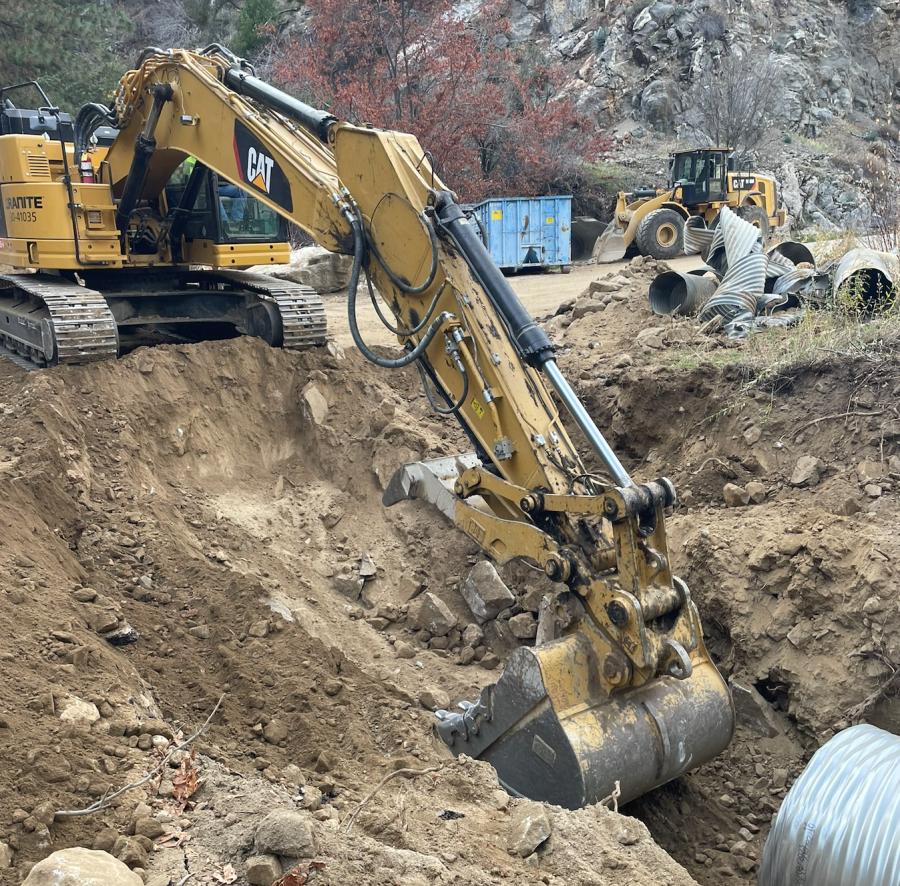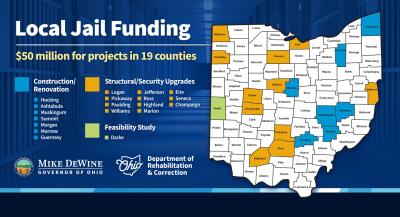Photo courtesy of Granite Construction
Granite Construction was tasked with making repairs at California’s Kings Canyon National Park in the southern Sierra Nevada after a total of four major washouts along SR 180 damaged the integrity of the roadway and blocked access to the Sequoia National Forest.
While Southern California contends with a historic atmospheric river, causing mudslides, crews from Granite Construction are engaged in road repairs and clearing operations caused by previous rock and mudslides in several areas to restore access through the Sequoia National Forest near Kings Canyon National Park (KCNP) in the southern Sierra Nevada mountain range.
The contract was awarded to Granite last August by the California Department of Transportation (Caltrans) and is expected to be completed in June.
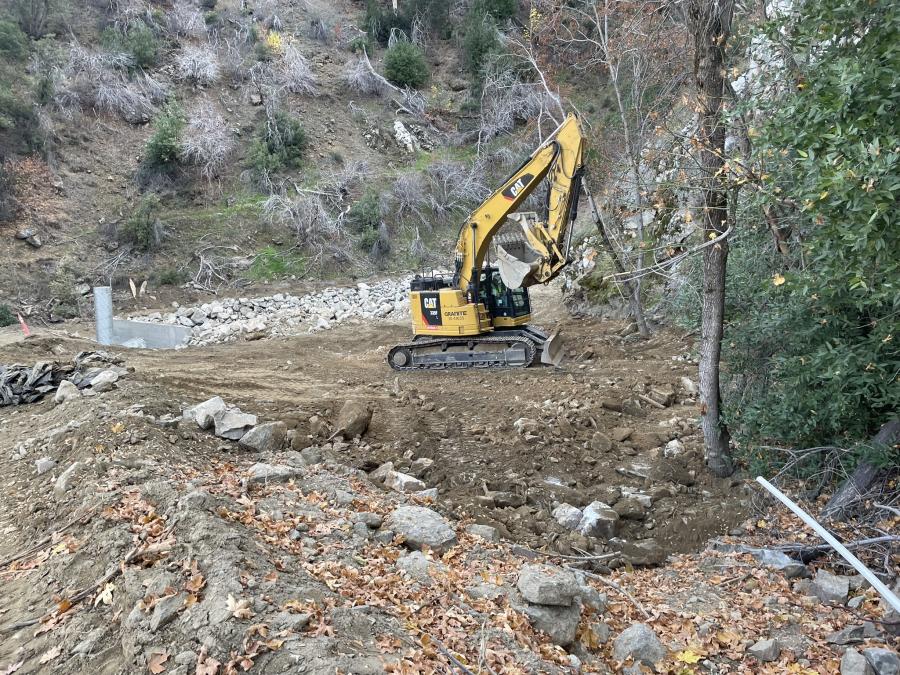
Photo courtesy of Granite Construction
"Granite has a long history of partnering with Caltrans District 6 to find innovative solutions to urgent and complex transportation system needs," said Granite Vice President of Regional Operations Carter Rohrbough.
"There was a total of four major washouts along SR 180 that damaged the integrity of the roadway and blocked access, three of which impacted lanes for travel in both eastbound and westbound directions," said Alex Aguilera, Caltrans public information officer, District 6.
To date, Granite has completed washout repairs, cleaned and repaired existing culverts, installed new culverts and headwalls and finished slide cleanup. Over the next few months, efforts will focus on the installation of wood lagging and steel piles for a retaining wall, rebuilding a failed slope with wire mesh baskets, rock, soil and geo grid fabric. Roadway improvements — including concrete barrier, safety enhancements, paving repairs and placement of erosion control products — all are on tap.
The project has its fair share of challenges.
"We're working in a remote location with little to no cell service," said Jeff Grimm, Granite's Fresno area manager. "The project team set up Starlink and a base camp for safety and communication. The project is 20 miles long and required our teams to work multiple headings simultaneously to adequately progress the work. This has created communication and logistic challenges that required extra planning to keep crews safe. The terrain is steep and rocky — just driving between work locations can be dangerous.
"Snow and ice are also issues," he added. "The work is primarily at elevations between 3,000 to 4,000 feet, however, accessing the work requires traversing a pass at 6,800 feet. Usually this section of highway is closed from November to May each year, but due to damage from the hard winter of 2022-2023, this section of roadway has been impassable and remained closed to the public since November 2022. To keep the work moving, Granite is maintaining the roadway by plowing and sanding to remove snow and mitigate icy conditions, which allows the work to continue during the winter months."
Safety is a constant concern and taken very seriously.
"Due to the steep terrain and tightly radiused corners with rock outcroppings, most deliveries of equipment and materials happen miles above the actual work locations in a large turnout called the Helipad — named for the fact it is an actual dirt Helipad for emergency fire and evacuation equipment during the summer months — at the top of the mountain," Grimm explained.
This requires double handling of most deliveries and tracking equipment long distances, so logistics are not easy.
To assess the work early in construction, a small side-by-side ATV was used to gain access to portions of the job where regular-sized vehicles were not an option. Many work locations required 4-wheel drive trucks to transport crews and navigate the poor road conditions, especially during inclement weather.
"The storm damage eroded many sections of the roadway where an entire lane or more has been washed away leaving barely a single lane of travel and in some instances on blind curves." said Grimm. "We've used two-way radios for communication around blind curves."
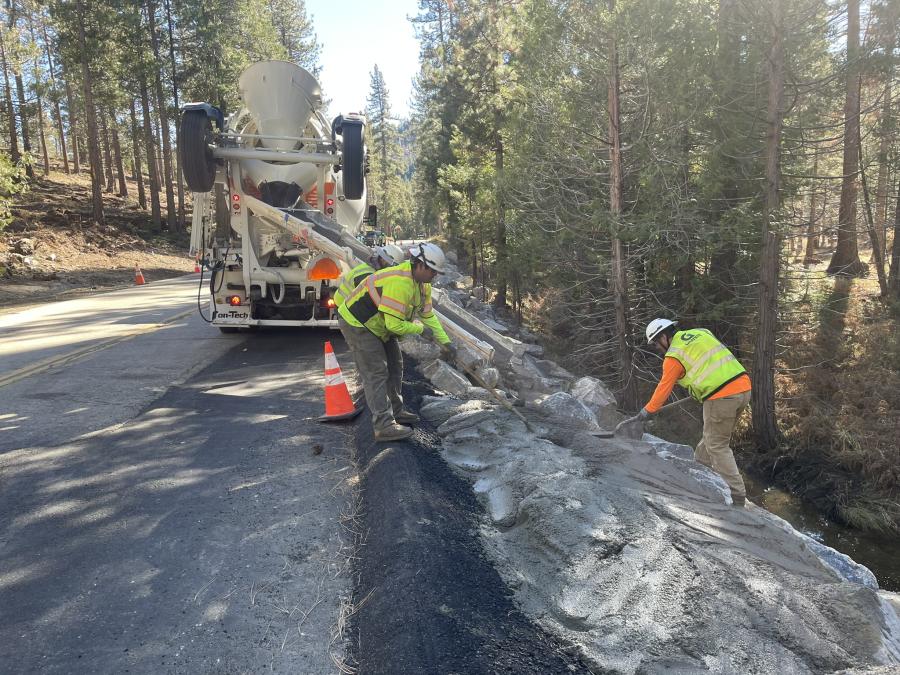
Photo courtesy of Granite Construction
On the positive side, there are no utility issues.
Granite has provided crew accommodations to support the teams working on the project.
"We have employees staying on-site in RV trailers at our base camp where internet service is provided," said Grimm. "Employees have the option to stay on-site or drive home."
The plan for the clearing and removal of the debris is based on reuse and minimizing the transportation of materials off-site. The debris consisted of rock, dirt and vegetation.
"Granite's plan is to use the material from the mud/rockslides to construct embankments at the washouts around the project," Grimm explained. "Most of the material has been removed from the roadway at this stage of the work. Rock from the rockslides was salvaged and sized when needed by blasting, screening or with the use of hydraulic hammers and reused on-site as rip-rap and common fill. Some rocks that fell onto the roadway were nearly the size of a school bus. The use of existing on-site material eliminated costly export and import of replacement materials, helping reduce the overall cost of the repairs significantly. Vegetation debris was hauled offsite to dump."
Most of the material was separated on-site when doable.
"This reduced the material that needed to be exported from the site and maximized the amount of material that could be incorporated into the reconstruction process," continued Grimm. "There are soil grading requirements for the embankment construction, so Granite ran the material through a grizzly screen to make a 3-inch minus material."
Approximately 60,000 cu. yds. of soil and rock have been moved throughout the site using Super 10-wheeler trucks and a Cat 740B haul truck.
Given the extreme nature of the project site, the right equipment was crucial for the success of these operations. Crews also used: Cat excavators: two 352s (one with a breaker excavator), 320, 330, 335 and a 308 (mini); loaders: a Cat 966, Cat 963 track loader and several John Deere models — a 744 and 210 skip loader; a John Deere 710 backhoe; Cat D6 and D4 dozers; and a Cat 140 motor grader.
The construction of the retaining walls required a change in plans.
"Originally it was anticipated that several walls and even a viaduct would need to be constructed to safely restore and reopen the roadway," said Grimm. "However, Caltrans and Granite collaborated on design solutions for each repair area and only one soldier pile wall and one stabilized soil wall are being constructed. Other locations were repaired using conventional earthen fills and many of the slopes were stabilized with rip-rap from on-site rock slides or mined from on-site locations."
The plan of attack has crews drill for piles and then install lagging, ground anchors, piping and slab and barrier wall. Materials include steel piles, timber lagging and concrete slab and barrier.
The retaining walls are up to 10 ft. below the existing roadway on the down slope side.
"Working next to a steep slope posed a safety challenge," said Grimm.
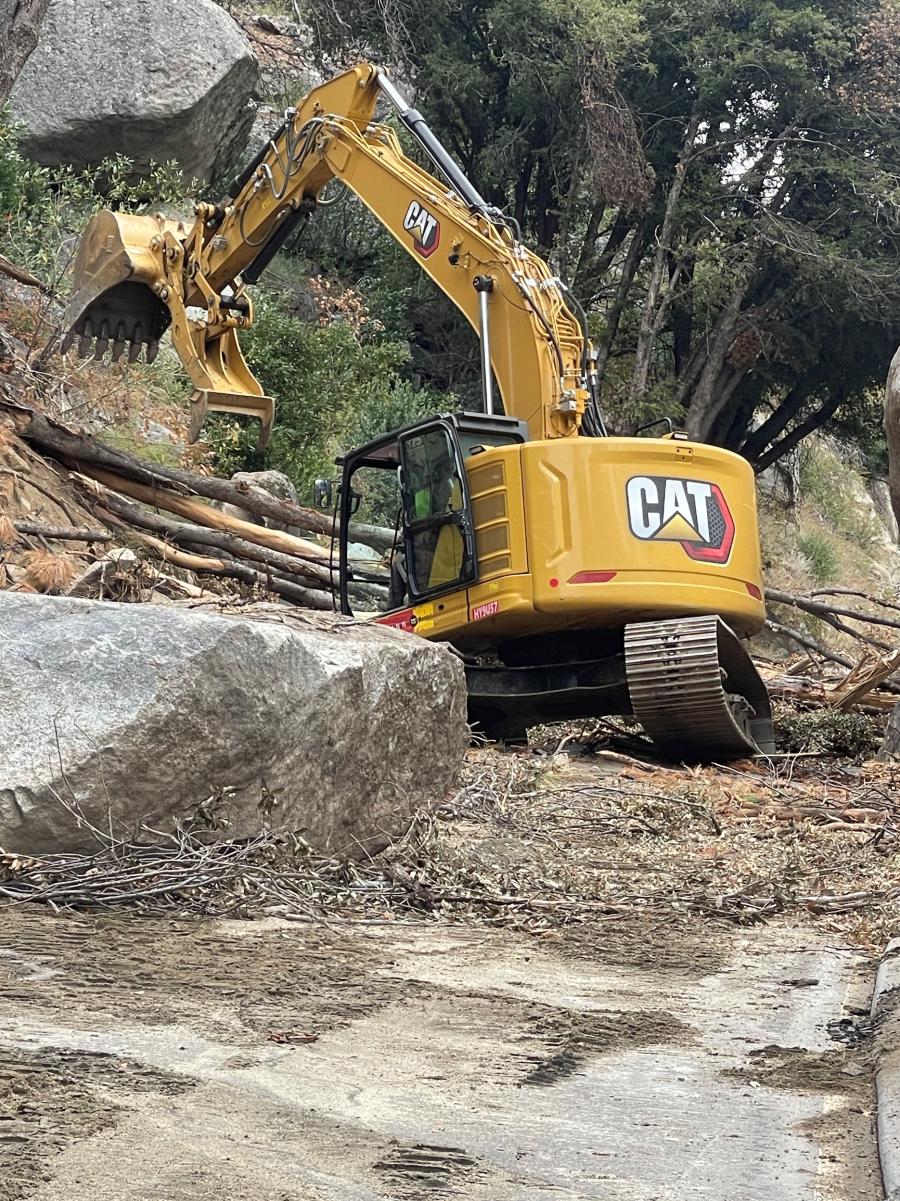
Photo courtesy of Granite Construction
This work has operators using a Komatsu PC490 LC-10 excavator, a TR150-60 auger, John Deere excavators and a reach lift.
For drainage systems, crews are installing corrugated metal pipe and other elements.
"Some of the drainage systems require the installation of cast-in-place concrete headwalls," said Grimm. "One system required the installation of pipe, a drain inlet and a grated line drain. Determining the size and quantity of each system, dig/set pipe and backfill was a factor in the work. The challenges were digging and setting in steep terrain. We utilized a track loader for this. All the systems were in the roadway and access was cut off to the job site during installation."
Drain inlet and a grated line drain are among the construction materials used.
The reconstruction of sections of SR 180 is addressing various types of damage to the asphalt surface including divots from falling rock, potholes from failed culverts, failures from mud and rockslides on top of the roadway and areas where the entire roadway was destroyed from fill slope failures and erosion.
"We will fine grade and place asphalt during spring when temperatures are favorable," said Grimm. "Currently, aggregate base is placed to allow the highway to be passible and we are reestablishing failed shoulders and guardrail only."
Granite's management team includes Construction Manager Kevin Paul, Project Manager Chris Fiester and Project Superintendent Eric Rawls.
"The team is collaborative, innovative and adaptive to changing conditions," said Grimm. "The crews are hardworking and putting in long hours." CEG
Irwin Rapoport
A journalist who started his career at a weekly community newspaper, Irwin Rapoport has written about construction and architecture for more than 15 years, as well as a variety of other subjects, such as recycling, environmental issues, business supply chains, property development, pulp and paper, agriculture, solar power and energy, and education. Getting the story right and illustrating the hard work and professionalism that goes into completing road, bridge, and building projects is important to him. A key element of his construction articles is to provide readers with an opportunity to see how general contractors and departments of transportation complete their projects and address challenges so that lessons learned can be shared with a wider audience.
Rapoport has a BA in History and a Minor in Political Science from Concordia University. His hobbies include hiking, birding, cycling, reading, going to concerts and plays, hanging out with friends and family, and architecture. He is keen to one day write an MA thesis on military and economic planning by the Great Powers prior to the start of the First World War.
Read more from Irwin Rapoport here.
Today's top stories



